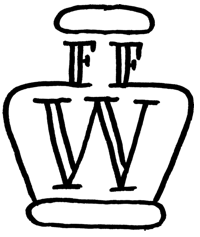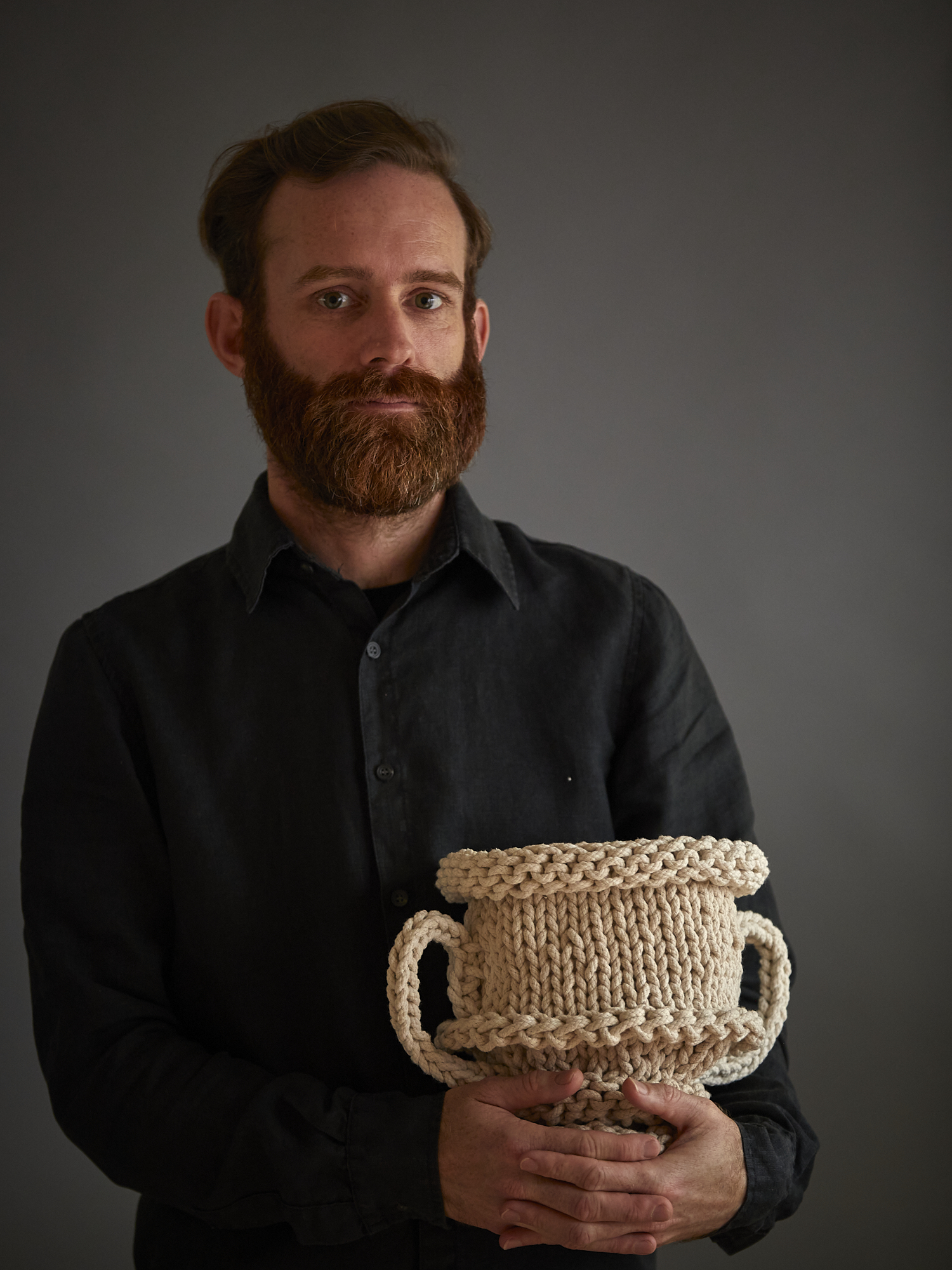
Ockham Lecture Series: Objectspace
11 Aug 2021
13 Rose Road,
Ponsonby, Auckland
Slow Making : Finn Ferrier / Finn McCahon-Jones
VIDEO RECORDING OF TALK HERE
https://vimeo.com/603527512
Edited transcript of talk:
This talk was originally delivered to a live audience at Objectspace.
It has been edited for this website.
Finn McCahon-Jones // Finn Ferrier:
Making A space
reading time 30 minutes / 4600 words
Most of my professional work is thinking about other people’s narratives not my own.
Thank you Objectspace for allowing me to look at myself momentarily, and give a space to share a story. This is a personal narrative about my experiences and practice. While I have been thinking about this talk and about Judy Darrah’s show Competitive Plastics I have been thinking about another JD. Julian Dashper, a mutual friend of mine and Judy’s and often referred to as the JD’s.
When I was at art school Julian Dashper would tell us to always think of yourself as an artist, even if you only felt like you were being an artist 1% of the time. He said if you travel - write your occupation as artist on the customs form; write artist in the census; say artist when people ask what you do. It’s just semantics, but it can orientate you; and give you permission to make a space for yourself.
![]() IMAGE: Finn Ferrier, 2020. Photo: F. Ferrier
IMAGE: Finn Ferrier, 2020. Photo: F. Ferrier
I was thinking about how I should introduce my ropework. I am going to read to you the wall-text to my show Finn Ferrier: Soft Garniture which was exhibited at Te Uru in December 2020 – February 2021.
“ Finn Ferrier has always loved rope, both as an object and a material, and how rope speaks the language of potential. Made from fibres, friction and tension; rope, twine and thread are usually only thought about for their practical applications.
These vessels came about when Ferrier started exploring nautical knotwork. He reimagined the decorative pursuits of sailors and created these objects as a logical progression of decorative knotwork. The forms on display come from a merging of traditional ceramic forms with the pliability of rope.
More recently Ferrier has been researching the history of woven vessels. Archaeological evidence suggests that ropework, in the form of basket making, has always been in close association with ceramics. In ancient times fresh clay was used to line baskets to make them into water-tight vessels. It is argued that coiled pottery gets its form from coiled baskets.
In this exhibition, Ferrier has treated his ropeware vessels as a garniture – a collection of decorative objects displayed together on a shelf.
Garnitures are often about assembling ornate pieces that represent various occasions or exchanges, and Ferrier’s pieces are no different. Within this display, you’ll see references to paintings, architecture, craft histories, the human body and the landscape.
Ferrier’s forms reference ceramic vessels, but take a departure into their own direction allowing the materiality of the rope to inform the final outcomes. They are re-shapable, reversible, and humble in their simplicity of form. Ferrier negotiates gravity and symmetry as he builds each vessel knot by knot.”
(Exhibition text by Chloe Geoghegan / Finn Ferrier)
![]()
IMAGE: Finn Ferrier: Soft Garniture, Te Uru Art Gallery, Auckland, 2020. Photo S. Hartnett / Te Uru
![]() IMAGE: Finn Ferrier: Soft Garniture, Te Uru Art Gallery, Auckland, 2020. Photo S. Hartnett / Te Uru
IMAGE: Finn Ferrier: Soft Garniture, Te Uru Art Gallery, Auckland, 2020. Photo S. Hartnett / Te Uru
![]() IMAGE: Finn Ferrier: Soft Garniture, Te Uru Art Gallery, Auckland, 2020. Photo: F. Ferrier
IMAGE: Finn Ferrier: Soft Garniture, Te Uru Art Gallery, Auckland, 2020. Photo: F. Ferrier
When I was working on this text I wanted it to talk about the sum of the parts of my objects. That they are not just a singular flat object, but a coming together of technology, temporality and materiality. As I have been working on this narrative tonight, I realise that there is no simple or singular answer to why I make rope objects, but a tangled set of relationships that have led me here. We all live in our own heads and never know if how we see the world is similar to someone else. Then I saw the flaming kebab sign in Judy Darrah’s competitive Plastics exhibition down stairs. I was itching to know if it was referencing the sign on the corner of K’Rd and Queen Streets. When I saw Judy last week I asked her.
It was. I knew it.
I remember seeing this sign. Last year? I can’t remember when, but I think I wrote about it in my notebook. It was so strange and bright and alive as it wiggled and emulated flames outside the kebab shop. It was unlike anything I had seen, I don’t know why it was so mesmerising. Perhaps because the shop looked like it was on fire, or just the slow rhythmic movements of the simulated LED flames. I didn’t want to buy a kebab, but I did want to look at the flames, they had agency.
When I look at Darrah’s show, I am taken at how she has turned all the objects in the exhibition back into material. She has taken the associated social preciousness or assumptions around these objects and transformed them into matter, which she has re-formed into new work with new relationships and a different kind of preciousness. Everywhere in this show Darrah mines our local environment and presents it as a strange entity. I get a glimpse into how Judy might see the world, not as a cohesive whole, but a world made of parts: Part shoe, part design, part fashion, part textile, part process, part colour, part practical, part terrible, part exciting. Darrah highlights that objects have movable histories and temporalities that are not fixed, if we can go beyond how they appear to us in this moment.
This is how I like looking at things too. I like looking at the phenomenal layers contained in the things we have around us. I like thinking about the temporality of an object and how it became to be. I spend hours on youtube looking at how things are made, and researching why particular materials are in use or why they look like they do. When I make objects I am constantly thinking about the relationships and histories contained in the material and what I am doing with it.
![]() IMAGE: Studio, 2021. Photo: F. Ferrier
IMAGE: Studio, 2021. Photo: F. Ferrier
Rope is a very practical material. Ropes are usually manufactured for special purposes in industry. They have to perform in a certain way to a standard. Rope is designed to work under load. When I work with rope, however, I’m giving it a holiday.
I often write to rope manufacturer asking for rope samples. They ask me what my intended purpose is, I say making art objects. After a blank moment we have an awkward exchange and I end up describing a sensual object. I tell them about the qualities I am looking for in a rope. I’m interested in how soft it is, or how does it bend, does it have good friction. Does it look nice. Most manufacturers get excited because I’m asking strange questions and I’m not interested in the tensile strength. I think they get excited because they get to use their knowledge gained by handling the materials, rather than quote facts from a spreadsheet.
These ropeworks are made as part of my Wharfware series. The name comes from a narrative I developed around this work, imagining that they are the production of a sailor. So they were ‘wares’ made on the wharves. I can’t remember how or why I dreamed this up, but I was probably 23 and had just left art school.
My first job after art school was at Auckland Museum, where I worked half time between the shop and the collection. I loved the juxtaposition between selling objects that represented the ones in the museum; and working with the real objects in the collection. I soon became full-time working with the Decorative Arts Collection.
My favourite visits were from the Unitec jewellery department where Pauline Bern and Alan Preston would bring in their students to look at the Museum’s collection. Since they didn’t know what the museum had, I would take the same brief that they gave to their students to make jewellery, but I would use the brief to findjewellery.
A concept that was introduced to me through these encounters was the ‘critique of preciousness’ which is an underlying theme in most contemporary jewellery practice. The main idea is that the value of the object lies in the concept, production, or social meaning of the jewellery – rather than the material worth of the metal or stones.
![]() IMAGE: Finn Ferrier, Sisal Urn with Double Belt (2020). Photo: S. Hartnett
IMAGE: Finn Ferrier, Sisal Urn with Double Belt (2020). Photo: S. Hartnett
My early ropework was made from sisal, which is a fibre from a type of agave. I was particularly attracted to sisal because it resembles the dried plant fibre it is made from. I liked how the material expressed its own origin. It made me think about the countless others who have worked with the same material across time. How the same material has been produced or used by a changing society.
At art school I built a museum and displayed pieces of rope I had found on the road. I liked how squashed rope became fibres again.
Playing with rope spurred me on to make my own jewellery. Rope is pretty cool stuff. Made of hundreds of fibres twisted together to form filaments, which are twisted again to make cords twisted again to make rope. It is the surface area of the collective fibres and all the friction that makes it strong. I don’t know how old rope is, but the idea that you can combine lots of fibres to make one large sturdy object has been exploited by animals and humans for millennia.
![]() IMAGE: Finn Ferrier, sisal brooches, circa 2006. Photo: S. Hartnett
IMAGE: Finn Ferrier, sisal brooches, circa 2006. Photo: S. Hartnett
In the mid 2000s I made a series of sisal brooches bound together onto a brooch-back with string. I sold them at the Room 103 shop in Achilles House.
I pinned a rope brooch to my own jacket and wore it everywhere. I liked how people would question it. I was asked if it was a symbol for a club, or on one occasion a woman dripping in bright yellow gold had a long conversation with me trying to understand how rope could be considered jewellery at all. I earnestly told her about the critique of preciousness.
I still remember having dinner with playwright Warwick Broadhead who saw all sorts of sexual connotations in it and made me blush to my full extent. I was experiencing how conceptual jewellery worked – I was fascinated by how it was projecting ideas.
![]() IMAGE: Glass swan, unknown maker, Australian Glass Manufacturers, Auckland.
IMAGE: Glass swan, unknown maker, Australian Glass Manufacturers, Auckland.
c. 1940. Photo/ Attribution: Finn McCahon-Jones
The concept of Wharfware strengthened when I was putting together the Decorative Arts Galleries with Louis LeVaillant at Auckland Museum. He introduced me to “homers” things that factory workers made themselves at lunchtime to adorn their homes.
Glassworkers would pull swans from lumps of molten glass; brickworks staff would make umbrella stands with cut down pipes and decorate them with scratches and lumps of clay; or things like mantle dogs and urns. I love these crude objects.
They contained the raw artistic skill of the maker but still looked like the raw object they were made from. They exist as both a material and an idea.
I took this idea of the vernacular object and applied this to my ropework and imagined what a sailor’s home might look like.
Conceptually my rope jewellery was an imagined adornment for a salty-seadog coming to shore. It was also a partly serious attempt to make “manly jewellery” I was interested in making an object that might appeal to men that had no interest in jewellery. However most of my brooches, I was told, sold to women.
But, I was included in an exhibition in 2013 called ‘Man Made’ at the Dowse.
![]()
IMAGE: Man Made, Dowse Art Museum, Lower Hutt, 2013. Photo: Dowse Art Museum
![]() IMAGE: Three works RHS - Finn Ferrier, rope necklaces installation image : Man Made, Dowse Art Museum, Lower Hutt, 2013. Photo: Dowse Art Museum
IMAGE: Three works RHS - Finn Ferrier, rope necklaces installation image : Man Made, Dowse Art Museum, Lower Hutt, 2013. Photo: Dowse Art Museum
This show was a survey of men working with textiles. The exhibition was broaching the old stereotypes that textiles were women’s business. My dad taught me how to sew. I didn’t know this was even a thing until I went to art school, and some of the teachers wanted to play out these tropes. Anyway, I was happy to have work included.
Sailors have traditionally made flat decorative knots, mats and rope as a way to pass time and adorn their surrounds. I see my ropework as the logical progression of nautical knotwork.
I had already made jewellery for coming ashore and thought how could this be extended. So I started working on objects and in 2012 I made my first vase.
I don’t know how the first vase actually came to be, but I remember being very excited when I had made it and brought it into the Museum lunchroom to show it off.
What I expected a marine biologist, a botanist or an entomologist to say – I don’t know. They just looked bewildered and tried to give me practical advice of how to make it better.
I kept making forms, and as part of the Wunder Week jewellery event in 2015, I installed a pop-up exhibition at the Maritime Museum. It was very satisfying having an exhibition in the home of real salty rope.
![]() IMAGE: Finn Ferrier: Wharfwear / Wharfware. New Zealand Maritime Museum, Auckland, 2015. Photo: F.Ferrier
IMAGE: Finn Ferrier: Wharfwear / Wharfware. New Zealand Maritime Museum, Auckland, 2015. Photo: F.Ferrier
![]() IMAGE: Finn Ferrier: Wharfwear / Wharfware. New Zealand Maritime Museum, Auckland, 2015. Photo: F.Ferrier
IMAGE: Finn Ferrier: Wharfwear / Wharfware. New Zealand Maritime Museum, Auckland, 2015. Photo: F.Ferrier
For the Maritime Museum I developed the concept that sailors needed decorative objects that could survive the pitch and roll of the sea and wouldn’t break during a storm. And somewhere to display dried seaweed arrangements. And it was important that it could be unravelled into rope again in an emergency.
I liked the idea that I was simply coiling rope from one form to another, one piece of rope in another format, but essentially the same.
While I was writing this for tonight, thinking about why rope. I thought about my dad.
My dad worked in the forest service, and he had a knot for every occasion. His shed was full of stuff, you would have to step into the negative space between the piles of materials and collections arranged in haphazard ways. His rope, however, was always beautifully coiled and hanging from a hook behind the door. He had a range of lengths and thicknesses for jobs. He could make knots that could hold any weight – then with a simple thump, the knot would untie, never getting stuck or tangled.
I was in awe of this material – how the rope obeyed his commands. And how carefully he coiled it up again. He bought me a book of knots. I practiced them, but didn’t know their applications so gave up. But I did learn one truck-hitch that has served me well.
While I was at Auckland Museum I would always make sure my professional development KPIs were based in a craft. After arguing that I needed to have a practical understanding of craft to talk to makers they sent me to Auckland Studio Potters to learn how to throw. Peter Stichbury was my teacher. He said you should “always have the finished form in your mind. If you do not achieve that form, squash it and start again.” He argued that if you started making a vase and it ended up as a bowl, it would neither be a good bowl nor a good vase.
After learning how to throw but not having a wheel at home I decided to make pots out of rope. At the time it seemed logical using rope instead of clay. It meant that I could make pottery inside on the couch without getting muddy. My first rope objects were quite crude as I learned how to build them up. But very satisfying none the less. In 2015 Catherine Tsui included me in a show at Corbans “Reappraisal: The Pot Show”.
![]() IMAGE: Reappraisal: The Pot Show. Corbans Estate Art Centre, Auckland. 2015. Curated by Kathryn Tsui. Photo: E. Blomeley
IMAGE: Reappraisal: The Pot Show. Corbans Estate Art Centre, Auckland. 2015. Curated by Kathryn Tsui. Photo: E. Blomeley
![]() IMAGE: Reappraisal: The Pot Show. Corbans Estate Art Centre, Auckland. 2015. Curated by Kathryn Tsui. Photo: Finn Ferrier
IMAGE: Reappraisal: The Pot Show. Corbans Estate Art Centre, Auckland. 2015. Curated by Kathryn Tsui. Photo: Finn Ferrier
My Wharfware is a slow process. Made in the same fashion as ceramics, I work from the base up, slowly coiling around and around. My favourite shapes are the ones that move in two dimensions at the same time. Up and out.
Until recently I have looked at my ropework as ceramics. This is their origin, and I make them with my knowledge from throwing pots. I am aware that they are not ceramics. And that clay has a certain immediacy and plasticity that rope does not have. And rope has tension and integrity that ceramics do not have. In my latest forms I am trying to push the rope like potters push clay. What is the material agency of rope, and how can I push it to create forms that you can only create in rope. Where is the point of collapse.
I use my fingers to create these forms, just pushing and pulling the rope through itself. I have a spike and a loop to manipulate the rope if my tension becomes too tight. Basically I make these in the evening instead of watching TV or reading a book, it is a way to slow my thoughts and sometimes to supress them if I need to.
I have a couple of rules that I have imposed on myself while making: The main rule is there are no chemical bonds like glue or resin. The only thing that keeps my work together is friction. Second, I have to work out a way to make my forms in one continuous direction. The rope is not cut, I just tie in a new rope when I run out.
The reason for the rule is to limit the possibilities and to work within these limitations so I have an edge to push against. Also it is important to me that the material remains as rope. Even though it will probably never be uncoiled again, I know it could.
![]() IMAGE: Too Many Hangups, Tuesday Club, Auckland. Curated by Iain Cheeseman, 2020.
IMAGE: Too Many Hangups, Tuesday Club, Auckland. Curated by Iain Cheeseman, 2020.
photo: F. Ferrier
![]() IMAGE: Finn Ferrier, Explosion Urn Footed,(2020). Installation view - Too Many Hangups, Tuesday Club, Auckland, 2020. Photo: F. Ferrier
IMAGE: Finn Ferrier, Explosion Urn Footed,(2020). Installation view - Too Many Hangups, Tuesday Club, Auckland, 2020. Photo: F. Ferrier
![]() IMAGE: Finn Ferrier, Heavy Whorl Vase (2020). Photo: S. Hartnett
IMAGE: Finn Ferrier, Heavy Whorl Vase (2020). Photo: S. Hartnett
![]() IMAGE: Finn Ferrier, Reverse Fishtail Vase (2021). Photo: S. Hartnett
IMAGE: Finn Ferrier, Reverse Fishtail Vase (2021). Photo: S. Hartnett
I think about these vessels as slow rhythmic objects that have cycles. I look to shells and other sea creatures for their intervals and form. I like to think of each knot, or swelling bulge as a slow building energy. I also look to my own histories to inform the shapes.
Covid-19 Lockdown, 2020
During the first lockdown I made a chin-up bar and started doing a crazy amount of chin-ups which tore my abdominal muscles. I remember laughing with friends about how I had done this. Little did I know my swollen stomach muscles were masking the fact that my appendix had burst at exactly the same time and I was slowly poisoning myself.
I became very sick and was in and out of hospital for a month trying to get on top of my peritonitis. After another month of recovery they booked me in for surgery to remove my appendix.
After which, I was told not to cough, laugh or sneeze or my abdominal muscles could burst out the hole. I freaked out. The idea that I could go through surgery only to sneeze which would mean more surgery. I felt a lump poking out of my cut, I was sure it was a hernia.
It turns out I was just very skinny and it was the stitches and scar tissue poking through my skin. As they cut out my appendix the surgeon saw that my colon didn’t look great. I had to go in for more checks afterwards.
It turned out I had bowel cancer.
![]() IMAGE: Finn Ferrier, Hernia Vase (2020). Photo: S. Hartnett
IMAGE: Finn Ferrier, Hernia Vase (2020). Photo: S. Hartnett
![]() IMAGE: Finn Ferrier, Rising Protrusion Vase (2020). Photo: S. Hartnett
IMAGE: Finn Ferrier, Rising Protrusion Vase (2020). Photo: S. Hartnett
![]() IMAGE: Finn Ferrier, Colon Sculpture (2020). Photo: S. Hartnett
IMAGE: Finn Ferrier, Colon Sculpture (2020). Photo: S. Hartnett
The doctors apologised that they didn’t check for cancer when I first came in. They said I was too young and healthy to have cancer. It turns out my appendix burst because the cancer was growing on the end of it. They told me I was very lucky that it burst, otherwise they wouldn’t have found the cancer.
I quit everything.
I didn’t know how to talk about it. I still don’t know. This is the first time I have talked about it. I didn’t know what was going to happen. I was booked in to have the cancer cut out . Which also meant cutting out half my colon and a portion of my intestines along with it. It’s abstract being told you are going to have half your colon removed. And what that actually might mean.
I went home and made my colon out of rope – just so I could hold it. I think it’s the right size. I never took it into one of my meetings.
![]() IMAGE: Finn Ferrier, Half and Half Urn (2020). Photo: S. Hartnett
IMAGE: Finn Ferrier, Half and Half Urn (2020). Photo: S. Hartnett
I made this too. Thinking about halves.
The rope made sense. I was untangling rope and re-tangling it.
It was very intestinal.
The doctor told me that when your appendix bursts two things can happen – either you get very sick very quickly as you poison yourself. Or your intestines migrate over to your appendix and bind it closed, taking the brunt of the poisoning. The latter is what happened to me. My intestines used their own agency to protect me.
Every night for a month or so after surgery I could feel my intestines unravel and migrate back across my stomach. It’s a wild sensation.
![]() IMAGE: Finn Ferrier, Ascending, Transverse and Descending (2020) / (2021). Photo: F. Ferrier
IMAGE: Finn Ferrier, Ascending, Transverse and Descending (2020) / (2021). Photo: F. Ferrier
I didn’t tell many people that I had cancer. Or how sick I actually got.
I didn’t have to as everyone was dealing with lockdown. I was in hospital for a week hooked up to plasma and all sorts of drugs until I felt better, then I went home and made rope things all week until the antibiotics wore off and I went back to hospital. This happened for a couple of months. When I was not in hospital, or even when I was, I would post images to Instagram of what I had made when I was not in hospital. I was trying to create a semblance of control in my life.
It’s been 11 months since having my colon removed. I’m ok. I don’t need chemo. The cancer was 10 years old when they cut it out. And luckily only stage 1.
A friend recently complained to me that they had no idea I had been sick. That my Instagram account showed what she thought to be a very productive existence. This is what I wanted. My Instagram account was the only thing I had control over.
I couldn’t see a horizon.
I used to get annoyed at people sharing their ‘best lives’ on social media. Like it was some gross display of mastery over life. But after having the experience of being sick, and people thinking I was winning when actually I was not. I realise it is just a form of keeping it all together. If making a world on social media allows you to sustain your practice, who am I to complain. Sustaining something requires energy and effort. Most practices are not sustainable in a contemporary sense of the word. Anyone with a creative practice should be praised.
So now when I see people’s online presence, I realise I was thinking about it all wrong. I have no idea what their life is actually like. If they have the energy to make space to allow a practice to thrive. Even if it’s just for themselves. Think of Julian Dashper’s advice and call yourself an artist. Go for it.
After hospital, all I could do was lie in my day-bed, lovingly made for me in the living-room. Thank you Emma. Not going out, having very few visitors and feeling weak physically and mentally. Making stuff was a place to channel everything.
![]() IMAGE: Finn Ferrier, Boss Cup & Rising Protrusion Vase (2020) [Group shot]. Photo: S. Hartnett
IMAGE: Finn Ferrier, Boss Cup & Rising Protrusion Vase (2020) [Group shot]. Photo: S. Hartnett
However, In all this chaos and uncertainty I had a real breakthrough with my ropework. My forms got better, the shapes more confident, my understanding of tension and ability to work bigger. I created a series and assembled a body of work which became the works I showed at Te Uru earlier this year.
This year I have been working with The New Zealand Maritime Museum who have acquired a body of work to display in their new permanent galleries opening later this year, exploring themes of time and making. For a long time I never considered my ropework to be part of my practice. They were just things I made. However, working on this lecture tonight I realise that they are very much part of me - combination of all the elements that have made up my life.
Thank you for listening.
~~~~~~~~~~~~~~~~~~~~~~~~~~~~~~~~~~~~~~~~~~~~~~~~~~~~~~~~~~~~~~~~~~~~~~~~~~~~~~~~~~~~~~~~~~
This text was read live to an audience at Objectspace, Rose Road, Ponsonby, Auckland.11 August 2021
This lecture was commissioned by Objectspace to accompany Judy Darrah’s exhibition ‘Competetive Plastics’ (19 Jun–5 Sep, 2021) and is part of the Ockham Lecture Series.
https://www.objectspace.org.nz/exhibitions/competitive-plastics/
Thank you Objectspace for allowing me to look at myself momentarily, and give a space to share a story. This is a personal narrative about my experiences and practice. While I have been thinking about this talk and about Judy Darrah’s show Competitive Plastics I have been thinking about another JD. Julian Dashper, a mutual friend of mine and Judy’s and often referred to as the JD’s.
When I was at art school Julian Dashper would tell us to always think of yourself as an artist, even if you only felt like you were being an artist 1% of the time. He said if you travel - write your occupation as artist on the customs form; write artist in the census; say artist when people ask what you do. It’s just semantics, but it can orientate you; and give you permission to make a space for yourself.
 IMAGE: Finn Ferrier, 2020. Photo: F. Ferrier
IMAGE: Finn Ferrier, 2020. Photo: F. Ferrier
Ropework
I was thinking about how I should introduce my ropework. I am going to read to you the wall-text to my show Finn Ferrier: Soft Garniture which was exhibited at Te Uru in December 2020 – February 2021.
“ Finn Ferrier has always loved rope, both as an object and a material, and how rope speaks the language of potential. Made from fibres, friction and tension; rope, twine and thread are usually only thought about for their practical applications.
These vessels came about when Ferrier started exploring nautical knotwork. He reimagined the decorative pursuits of sailors and created these objects as a logical progression of decorative knotwork. The forms on display come from a merging of traditional ceramic forms with the pliability of rope.
More recently Ferrier has been researching the history of woven vessels. Archaeological evidence suggests that ropework, in the form of basket making, has always been in close association with ceramics. In ancient times fresh clay was used to line baskets to make them into water-tight vessels. It is argued that coiled pottery gets its form from coiled baskets.
In this exhibition, Ferrier has treated his ropeware vessels as a garniture – a collection of decorative objects displayed together on a shelf.
Garnitures are often about assembling ornate pieces that represent various occasions or exchanges, and Ferrier’s pieces are no different. Within this display, you’ll see references to paintings, architecture, craft histories, the human body and the landscape.
Ferrier’s forms reference ceramic vessels, but take a departure into their own direction allowing the materiality of the rope to inform the final outcomes. They are re-shapable, reversible, and humble in their simplicity of form. Ferrier negotiates gravity and symmetry as he builds each vessel knot by knot.”
(Exhibition text by Chloe Geoghegan / Finn Ferrier)
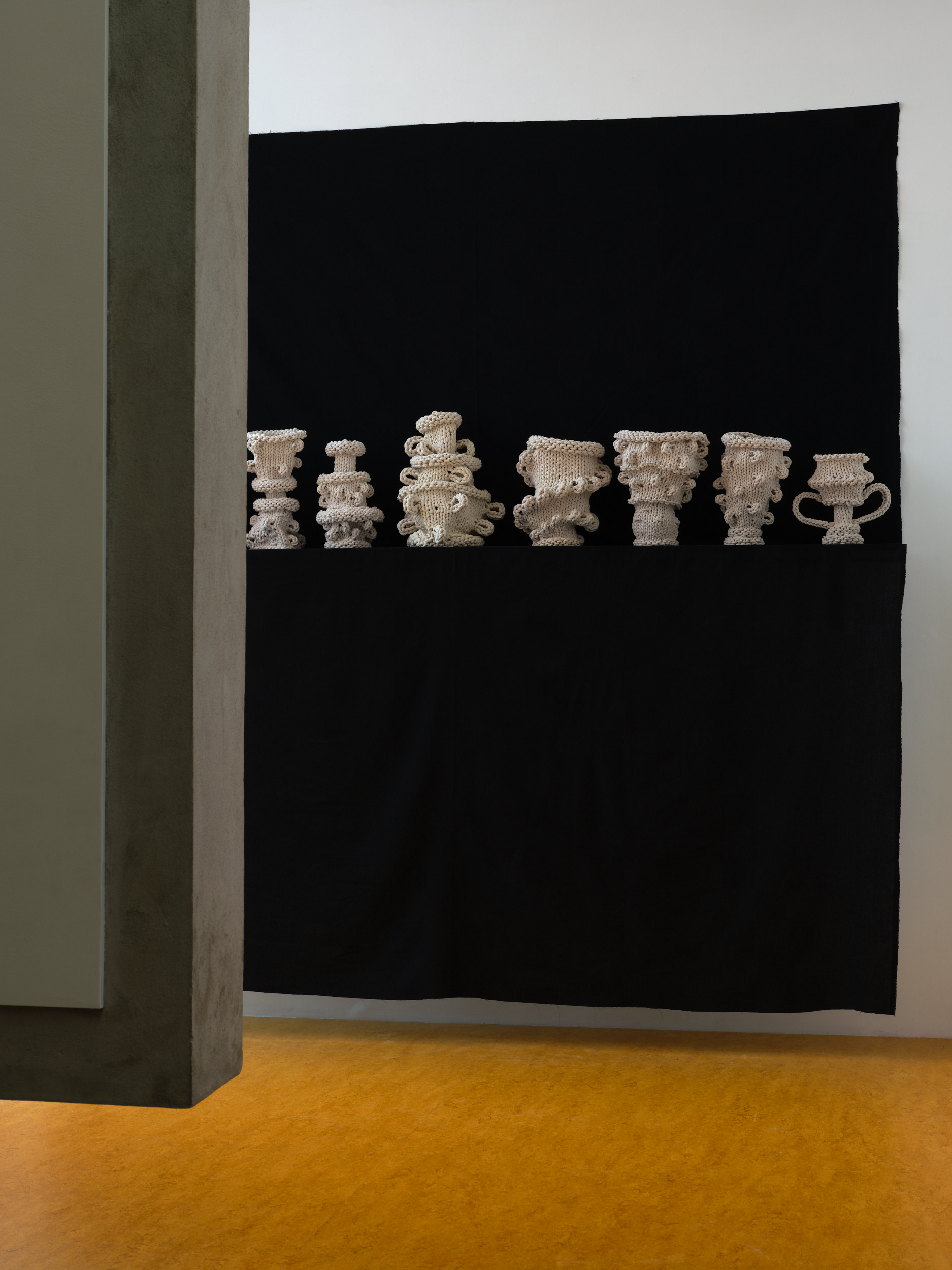
IMAGE: Finn Ferrier: Soft Garniture, Te Uru Art Gallery, Auckland, 2020. Photo S. Hartnett / Te Uru
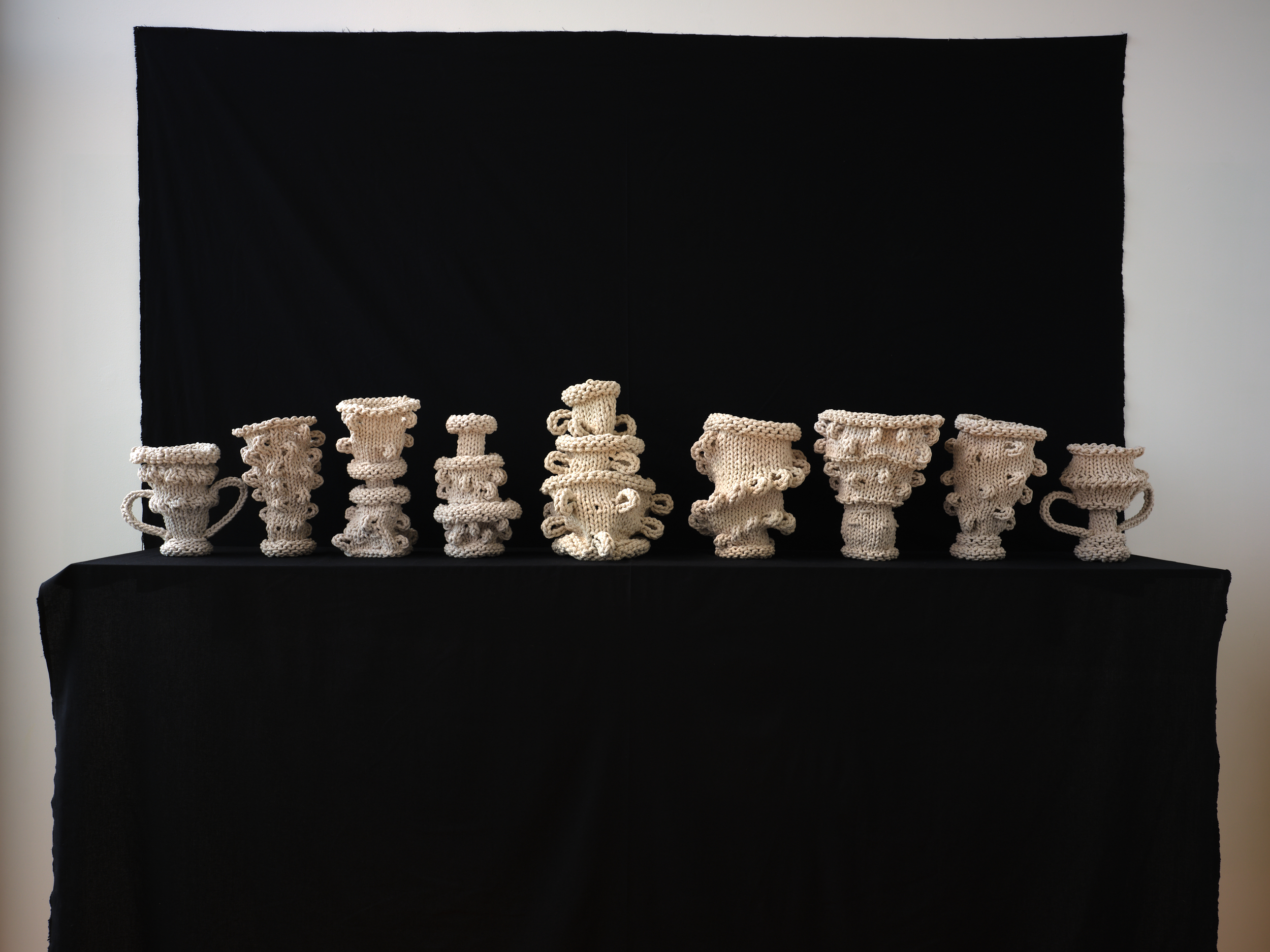 IMAGE: Finn Ferrier: Soft Garniture, Te Uru Art Gallery, Auckland, 2020. Photo S. Hartnett / Te Uru
IMAGE: Finn Ferrier: Soft Garniture, Te Uru Art Gallery, Auckland, 2020. Photo S. Hartnett / Te Uru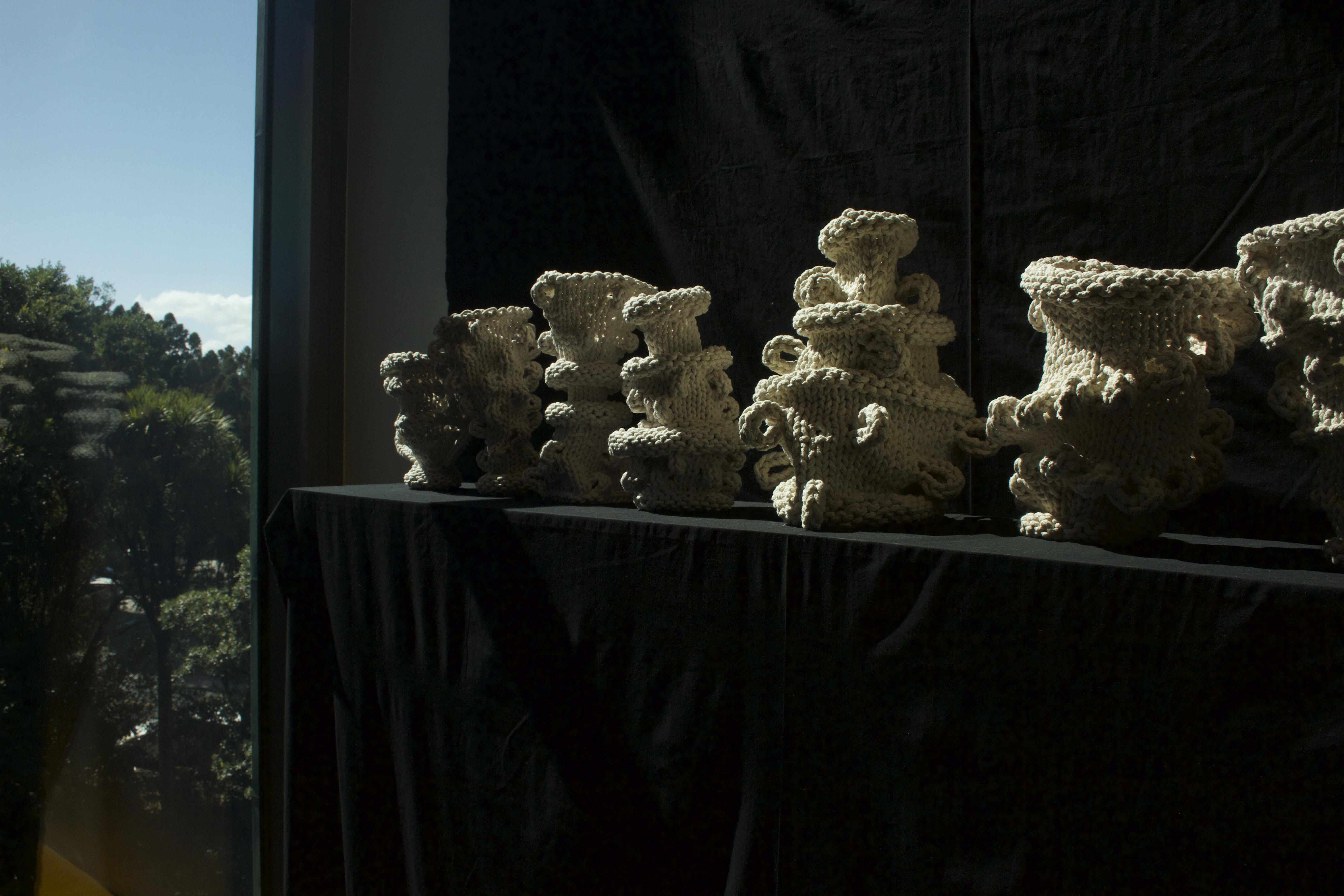 IMAGE: Finn Ferrier: Soft Garniture, Te Uru Art Gallery, Auckland, 2020. Photo: F. Ferrier
IMAGE: Finn Ferrier: Soft Garniture, Te Uru Art Gallery, Auckland, 2020. Photo: F. Ferrier
When I was working on this text I wanted it to talk about the sum of the parts of my objects. That they are not just a singular flat object, but a coming together of technology, temporality and materiality. As I have been working on this narrative tonight, I realise that there is no simple or singular answer to why I make rope objects, but a tangled set of relationships that have led me here. We all live in our own heads and never know if how we see the world is similar to someone else. Then I saw the flaming kebab sign in Judy Darrah’s competitive Plastics exhibition down stairs. I was itching to know if it was referencing the sign on the corner of K’Rd and Queen Streets. When I saw Judy last week I asked her.
It was. I knew it.
I remember seeing this sign. Last year? I can’t remember when, but I think I wrote about it in my notebook. It was so strange and bright and alive as it wiggled and emulated flames outside the kebab shop. It was unlike anything I had seen, I don’t know why it was so mesmerising. Perhaps because the shop looked like it was on fire, or just the slow rhythmic movements of the simulated LED flames. I didn’t want to buy a kebab, but I did want to look at the flames, they had agency.
When I look at Darrah’s show, I am taken at how she has turned all the objects in the exhibition back into material. She has taken the associated social preciousness or assumptions around these objects and transformed them into matter, which she has re-formed into new work with new relationships and a different kind of preciousness. Everywhere in this show Darrah mines our local environment and presents it as a strange entity. I get a glimpse into how Judy might see the world, not as a cohesive whole, but a world made of parts: Part shoe, part design, part fashion, part textile, part process, part colour, part practical, part terrible, part exciting. Darrah highlights that objects have movable histories and temporalities that are not fixed, if we can go beyond how they appear to us in this moment.
This is how I like looking at things too. I like looking at the phenomenal layers contained in the things we have around us. I like thinking about the temporality of an object and how it became to be. I spend hours on youtube looking at how things are made, and researching why particular materials are in use or why they look like they do. When I make objects I am constantly thinking about the relationships and histories contained in the material and what I am doing with it.
 IMAGE: Studio, 2021. Photo: F. Ferrier
IMAGE: Studio, 2021. Photo: F. FerrierRope is a very practical material. Ropes are usually manufactured for special purposes in industry. They have to perform in a certain way to a standard. Rope is designed to work under load. When I work with rope, however, I’m giving it a holiday.
I often write to rope manufacturer asking for rope samples. They ask me what my intended purpose is, I say making art objects. After a blank moment we have an awkward exchange and I end up describing a sensual object. I tell them about the qualities I am looking for in a rope. I’m interested in how soft it is, or how does it bend, does it have good friction. Does it look nice. Most manufacturers get excited because I’m asking strange questions and I’m not interested in the tensile strength. I think they get excited because they get to use their knowledge gained by handling the materials, rather than quote facts from a spreadsheet.
Wharfware
These ropeworks are made as part of my Wharfware series. The name comes from a narrative I developed around this work, imagining that they are the production of a sailor. So they were ‘wares’ made on the wharves. I can’t remember how or why I dreamed this up, but I was probably 23 and had just left art school.
My first job after art school was at Auckland Museum, where I worked half time between the shop and the collection. I loved the juxtaposition between selling objects that represented the ones in the museum; and working with the real objects in the collection. I soon became full-time working with the Decorative Arts Collection.
My favourite visits were from the Unitec jewellery department where Pauline Bern and Alan Preston would bring in their students to look at the Museum’s collection. Since they didn’t know what the museum had, I would take the same brief that they gave to their students to make jewellery, but I would use the brief to findjewellery.
A concept that was introduced to me through these encounters was the ‘critique of preciousness’ which is an underlying theme in most contemporary jewellery practice. The main idea is that the value of the object lies in the concept, production, or social meaning of the jewellery – rather than the material worth of the metal or stones.
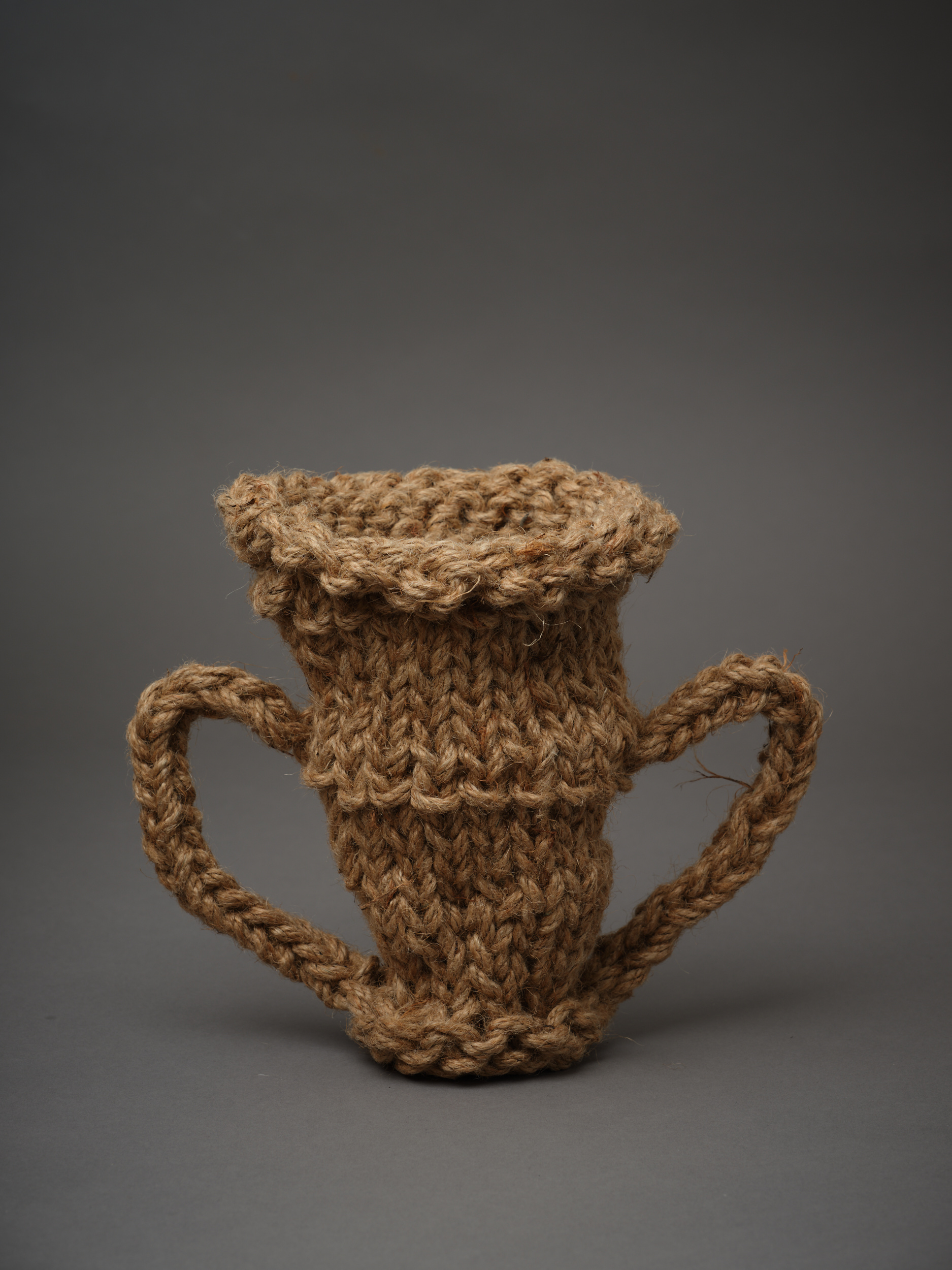 IMAGE: Finn Ferrier, Sisal Urn with Double Belt (2020). Photo: S. Hartnett
IMAGE: Finn Ferrier, Sisal Urn with Double Belt (2020). Photo: S. HartnettMy early ropework was made from sisal, which is a fibre from a type of agave. I was particularly attracted to sisal because it resembles the dried plant fibre it is made from. I liked how the material expressed its own origin. It made me think about the countless others who have worked with the same material across time. How the same material has been produced or used by a changing society.
At art school I built a museum and displayed pieces of rope I had found on the road. I liked how squashed rope became fibres again.
Playing with rope spurred me on to make my own jewellery. Rope is pretty cool stuff. Made of hundreds of fibres twisted together to form filaments, which are twisted again to make cords twisted again to make rope. It is the surface area of the collective fibres and all the friction that makes it strong. I don’t know how old rope is, but the idea that you can combine lots of fibres to make one large sturdy object has been exploited by animals and humans for millennia.
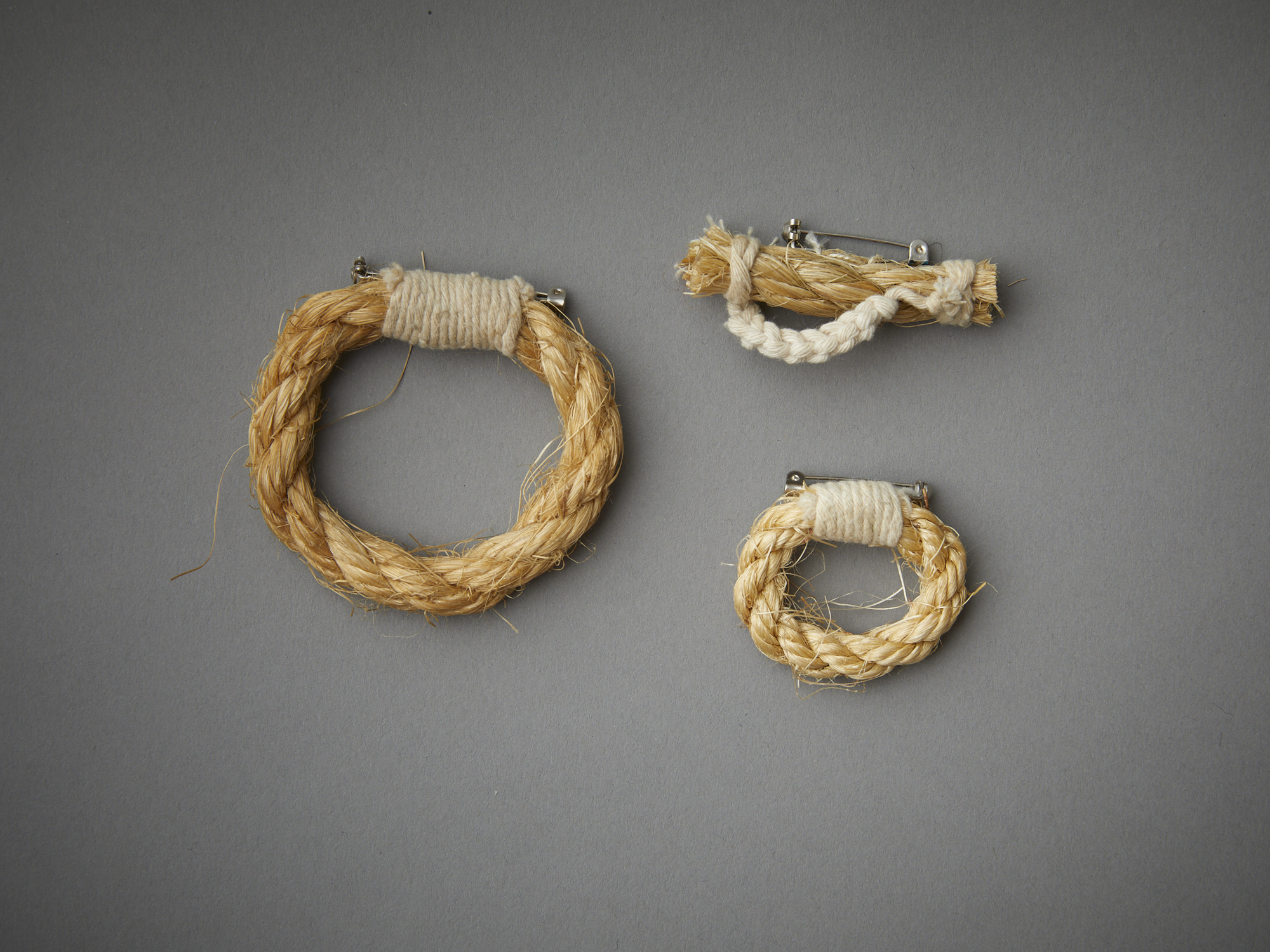 IMAGE: Finn Ferrier, sisal brooches, circa 2006. Photo: S. Hartnett
IMAGE: Finn Ferrier, sisal brooches, circa 2006. Photo: S. Hartnett
In the mid 2000s I made a series of sisal brooches bound together onto a brooch-back with string. I sold them at the Room 103 shop in Achilles House.
I pinned a rope brooch to my own jacket and wore it everywhere. I liked how people would question it. I was asked if it was a symbol for a club, or on one occasion a woman dripping in bright yellow gold had a long conversation with me trying to understand how rope could be considered jewellery at all. I earnestly told her about the critique of preciousness.
I still remember having dinner with playwright Warwick Broadhead who saw all sorts of sexual connotations in it and made me blush to my full extent. I was experiencing how conceptual jewellery worked – I was fascinated by how it was projecting ideas.
 IMAGE: Glass swan, unknown maker, Australian Glass Manufacturers, Auckland.
IMAGE: Glass swan, unknown maker, Australian Glass Manufacturers, Auckland. c. 1940. Photo/ Attribution: Finn McCahon-Jones
Auckland Museum
The concept of Wharfware strengthened when I was putting together the Decorative Arts Galleries with Louis LeVaillant at Auckland Museum. He introduced me to “homers” things that factory workers made themselves at lunchtime to adorn their homes.
Glassworkers would pull swans from lumps of molten glass; brickworks staff would make umbrella stands with cut down pipes and decorate them with scratches and lumps of clay; or things like mantle dogs and urns. I love these crude objects.
They contained the raw artistic skill of the maker but still looked like the raw object they were made from. They exist as both a material and an idea.
I took this idea of the vernacular object and applied this to my ropework and imagined what a sailor’s home might look like.
Conceptually my rope jewellery was an imagined adornment for a salty-seadog coming to shore. It was also a partly serious attempt to make “manly jewellery” I was interested in making an object that might appeal to men that had no interest in jewellery. However most of my brooches, I was told, sold to women.
But, I was included in an exhibition in 2013 called ‘Man Made’ at the Dowse.
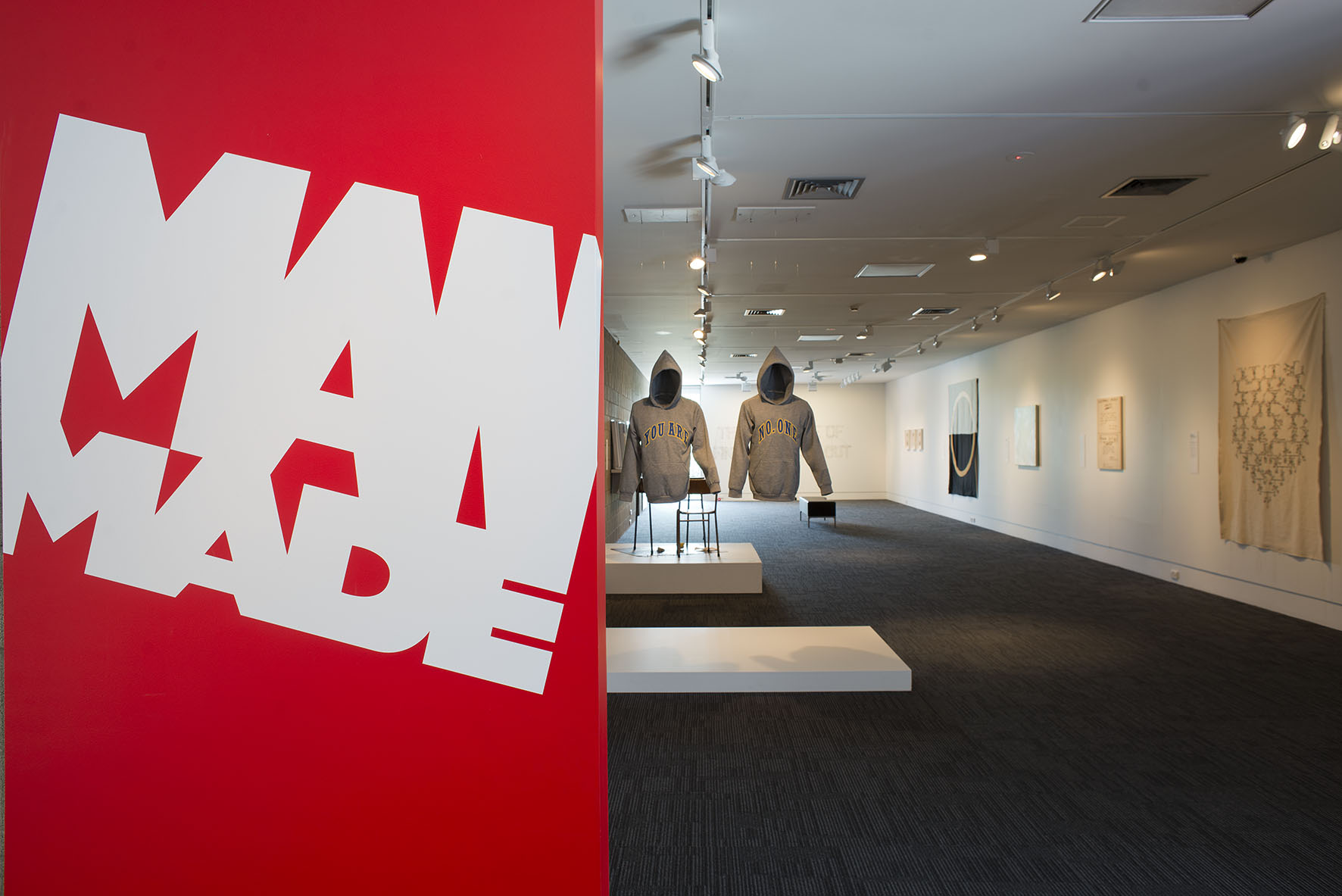
IMAGE: Man Made, Dowse Art Museum, Lower Hutt, 2013. Photo: Dowse Art Museum
 IMAGE: Three works RHS - Finn Ferrier, rope necklaces installation image : Man Made, Dowse Art Museum, Lower Hutt, 2013. Photo: Dowse Art Museum
IMAGE: Three works RHS - Finn Ferrier, rope necklaces installation image : Man Made, Dowse Art Museum, Lower Hutt, 2013. Photo: Dowse Art MuseumThis show was a survey of men working with textiles. The exhibition was broaching the old stereotypes that textiles were women’s business. My dad taught me how to sew. I didn’t know this was even a thing until I went to art school, and some of the teachers wanted to play out these tropes. Anyway, I was happy to have work included.
Sailors have traditionally made flat decorative knots, mats and rope as a way to pass time and adorn their surrounds. I see my ropework as the logical progression of nautical knotwork.
I had already made jewellery for coming ashore and thought how could this be extended. So I started working on objects and in 2012 I made my first vase.
I don’t know how the first vase actually came to be, but I remember being very excited when I had made it and brought it into the Museum lunchroom to show it off.
What I expected a marine biologist, a botanist or an entomologist to say – I don’t know. They just looked bewildered and tried to give me practical advice of how to make it better.
I kept making forms, and as part of the Wunder Week jewellery event in 2015, I installed a pop-up exhibition at the Maritime Museum. It was very satisfying having an exhibition in the home of real salty rope.
 IMAGE: Finn Ferrier: Wharfwear / Wharfware. New Zealand Maritime Museum, Auckland, 2015. Photo: F.Ferrier
IMAGE: Finn Ferrier: Wharfwear / Wharfware. New Zealand Maritime Museum, Auckland, 2015. Photo: F.Ferrier IMAGE: Finn Ferrier: Wharfwear / Wharfware. New Zealand Maritime Museum, Auckland, 2015. Photo: F.Ferrier
IMAGE: Finn Ferrier: Wharfwear / Wharfware. New Zealand Maritime Museum, Auckland, 2015. Photo: F.Ferrier
For the Maritime Museum I developed the concept that sailors needed decorative objects that could survive the pitch and roll of the sea and wouldn’t break during a storm. And somewhere to display dried seaweed arrangements. And it was important that it could be unravelled into rope again in an emergency.
I liked the idea that I was simply coiling rope from one form to another, one piece of rope in another format, but essentially the same.
While I was writing this for tonight, thinking about why rope. I thought about my dad.
My dad worked in the forest service, and he had a knot for every occasion. His shed was full of stuff, you would have to step into the negative space between the piles of materials and collections arranged in haphazard ways. His rope, however, was always beautifully coiled and hanging from a hook behind the door. He had a range of lengths and thicknesses for jobs. He could make knots that could hold any weight – then with a simple thump, the knot would untie, never getting stuck or tangled.
I was in awe of this material – how the rope obeyed his commands. And how carefully he coiled it up again. He bought me a book of knots. I practiced them, but didn’t know their applications so gave up. But I did learn one truck-hitch that has served me well.
Making pots
While I was at Auckland Museum I would always make sure my professional development KPIs were based in a craft. After arguing that I needed to have a practical understanding of craft to talk to makers they sent me to Auckland Studio Potters to learn how to throw. Peter Stichbury was my teacher. He said you should “always have the finished form in your mind. If you do not achieve that form, squash it and start again.” He argued that if you started making a vase and it ended up as a bowl, it would neither be a good bowl nor a good vase.
After learning how to throw but not having a wheel at home I decided to make pots out of rope. At the time it seemed logical using rope instead of clay. It meant that I could make pottery inside on the couch without getting muddy. My first rope objects were quite crude as I learned how to build them up. But very satisfying none the less. In 2015 Catherine Tsui included me in a show at Corbans “Reappraisal: The Pot Show”.
My Wharfware is a slow process. Made in the same fashion as ceramics, I work from the base up, slowly coiling around and around. My favourite shapes are the ones that move in two dimensions at the same time. Up and out.
Until recently I have looked at my ropework as ceramics. This is their origin, and I make them with my knowledge from throwing pots. I am aware that they are not ceramics. And that clay has a certain immediacy and plasticity that rope does not have. And rope has tension and integrity that ceramics do not have. In my latest forms I am trying to push the rope like potters push clay. What is the material agency of rope, and how can I push it to create forms that you can only create in rope. Where is the point of collapse.
I use my fingers to create these forms, just pushing and pulling the rope through itself. I have a spike and a loop to manipulate the rope if my tension becomes too tight. Basically I make these in the evening instead of watching TV or reading a book, it is a way to slow my thoughts and sometimes to supress them if I need to.
I have a couple of rules that I have imposed on myself while making: The main rule is there are no chemical bonds like glue or resin. The only thing that keeps my work together is friction. Second, I have to work out a way to make my forms in one continuous direction. The rope is not cut, I just tie in a new rope when I run out.
The reason for the rule is to limit the possibilities and to work within these limitations so I have an edge to push against. Also it is important to me that the material remains as rope. Even though it will probably never be uncoiled again, I know it could.
photo: F. Ferrier
 IMAGE: Finn Ferrier, Heavy Whorl Vase (2020). Photo: S. Hartnett
IMAGE: Finn Ferrier, Heavy Whorl Vase (2020). Photo: S. Hartnett IMAGE: Finn Ferrier, Reverse Fishtail Vase (2021). Photo: S. Hartnett
IMAGE: Finn Ferrier, Reverse Fishtail Vase (2021). Photo: S. Hartnett
I think about these vessels as slow rhythmic objects that have cycles. I look to shells and other sea creatures for their intervals and form. I like to think of each knot, or swelling bulge as a slow building energy. I also look to my own histories to inform the shapes.
Covid-19 Lockdown, 2020
During the first lockdown I made a chin-up bar and started doing a crazy amount of chin-ups which tore my abdominal muscles. I remember laughing with friends about how I had done this. Little did I know my swollen stomach muscles were masking the fact that my appendix had burst at exactly the same time and I was slowly poisoning myself.
I became very sick and was in and out of hospital for a month trying to get on top of my peritonitis. After another month of recovery they booked me in for surgery to remove my appendix.
After which, I was told not to cough, laugh or sneeze or my abdominal muscles could burst out the hole. I freaked out. The idea that I could go through surgery only to sneeze which would mean more surgery. I felt a lump poking out of my cut, I was sure it was a hernia.
It turns out I was just very skinny and it was the stitches and scar tissue poking through my skin. As they cut out my appendix the surgeon saw that my colon didn’t look great. I had to go in for more checks afterwards.
It turned out I had bowel cancer.
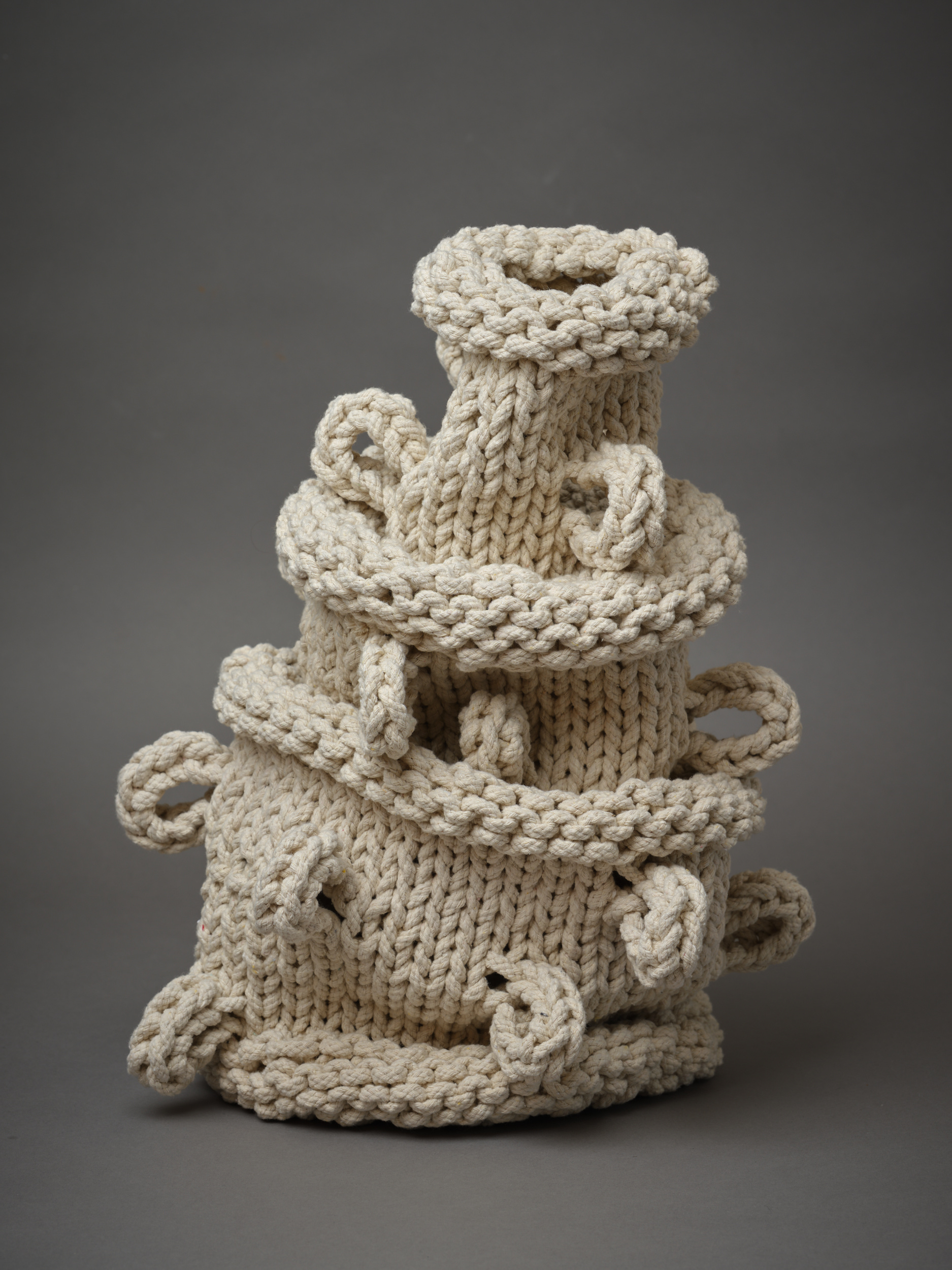 IMAGE: Finn Ferrier, Hernia Vase (2020). Photo: S. Hartnett
IMAGE: Finn Ferrier, Hernia Vase (2020). Photo: S. Hartnett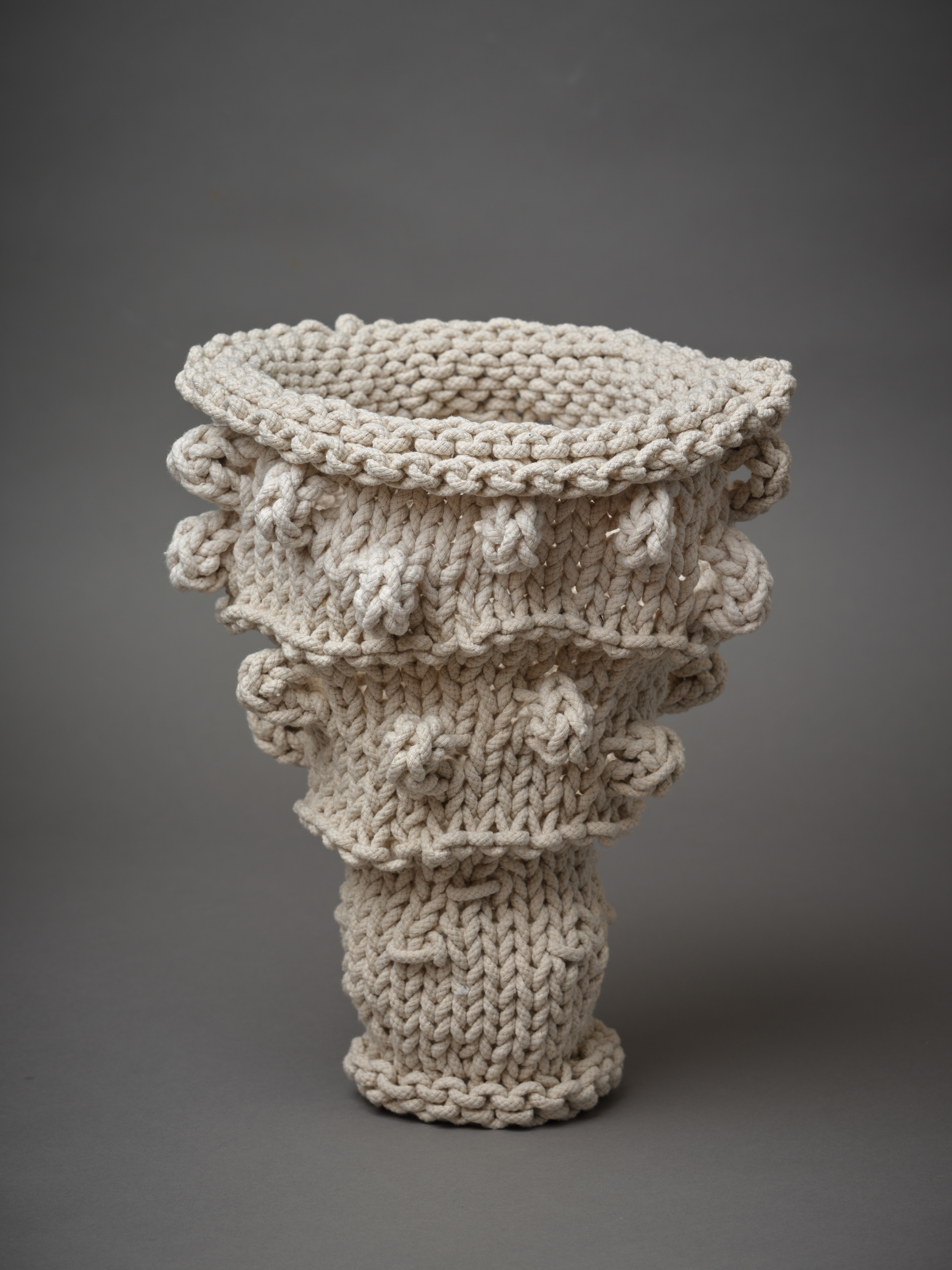 IMAGE: Finn Ferrier, Rising Protrusion Vase (2020). Photo: S. Hartnett
IMAGE: Finn Ferrier, Rising Protrusion Vase (2020). Photo: S. Hartnett
 IMAGE: Finn Ferrier, Colon Sculpture (2020). Photo: S. Hartnett
IMAGE: Finn Ferrier, Colon Sculpture (2020). Photo: S. Hartnett
The doctors apologised that they didn’t check for cancer when I first came in. They said I was too young and healthy to have cancer. It turns out my appendix burst because the cancer was growing on the end of it. They told me I was very lucky that it burst, otherwise they wouldn’t have found the cancer.
I quit everything.
I didn’t know how to talk about it. I still don’t know. This is the first time I have talked about it. I didn’t know what was going to happen. I was booked in to have the cancer cut out . Which also meant cutting out half my colon and a portion of my intestines along with it. It’s abstract being told you are going to have half your colon removed. And what that actually might mean.
I went home and made my colon out of rope – just so I could hold it. I think it’s the right size. I never took it into one of my meetings.
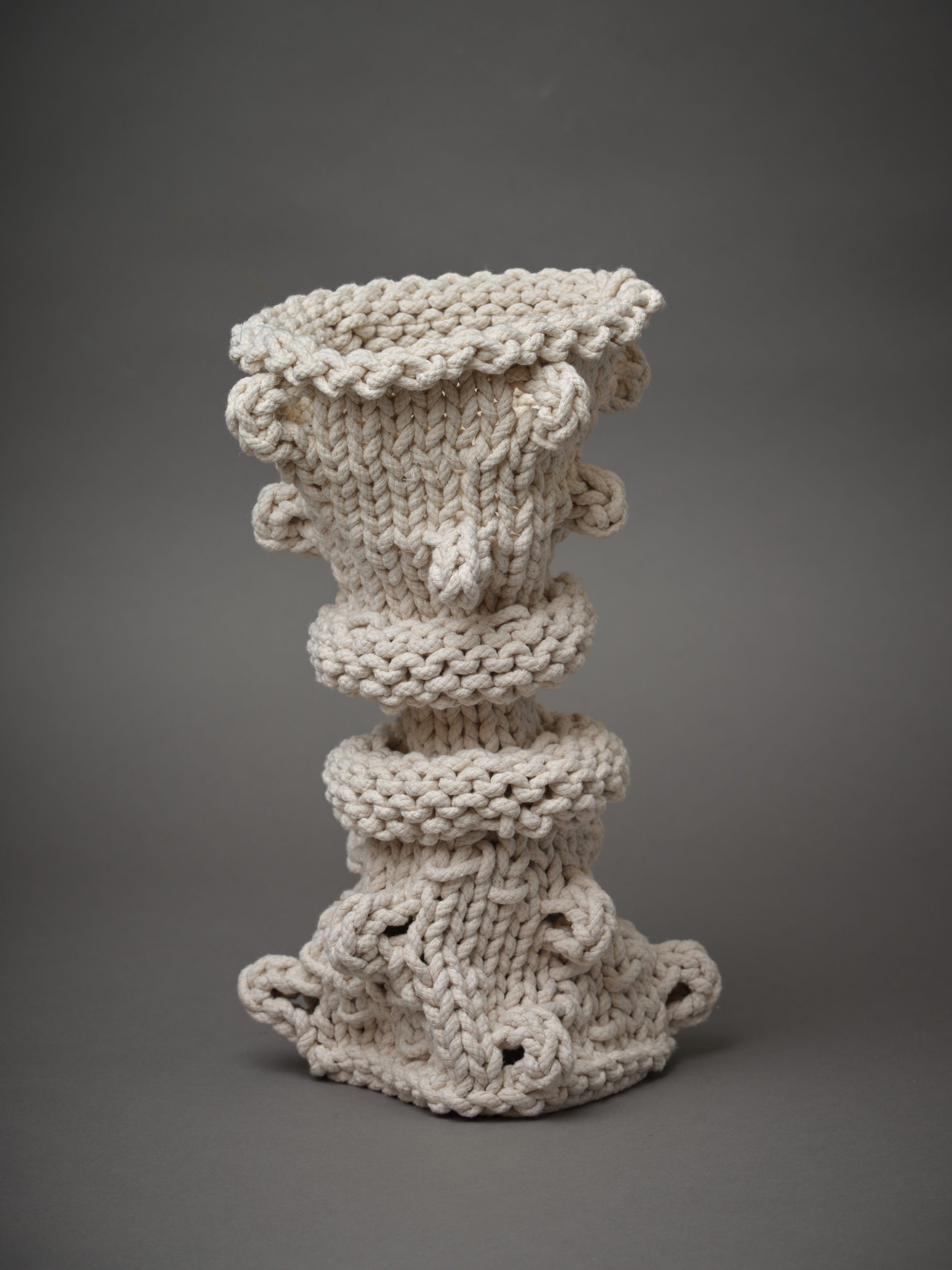 IMAGE: Finn Ferrier, Half and Half Urn (2020). Photo: S. Hartnett
IMAGE: Finn Ferrier, Half and Half Urn (2020). Photo: S. Hartnett I made this too. Thinking about halves.
The rope made sense. I was untangling rope and re-tangling it.
It was very intestinal.
The doctor told me that when your appendix bursts two things can happen – either you get very sick very quickly as you poison yourself. Or your intestines migrate over to your appendix and bind it closed, taking the brunt of the poisoning. The latter is what happened to me. My intestines used their own agency to protect me.
Every night for a month or so after surgery I could feel my intestines unravel and migrate back across my stomach. It’s a wild sensation.
I didn’t tell many people that I had cancer. Or how sick I actually got.
I didn’t have to as everyone was dealing with lockdown. I was in hospital for a week hooked up to plasma and all sorts of drugs until I felt better, then I went home and made rope things all week until the antibiotics wore off and I went back to hospital. This happened for a couple of months. When I was not in hospital, or even when I was, I would post images to Instagram of what I had made when I was not in hospital. I was trying to create a semblance of control in my life.
It’s been 11 months since having my colon removed. I’m ok. I don’t need chemo. The cancer was 10 years old when they cut it out. And luckily only stage 1.
A friend recently complained to me that they had no idea I had been sick. That my Instagram account showed what she thought to be a very productive existence. This is what I wanted. My Instagram account was the only thing I had control over.
I couldn’t see a horizon.
I used to get annoyed at people sharing their ‘best lives’ on social media. Like it was some gross display of mastery over life. But after having the experience of being sick, and people thinking I was winning when actually I was not. I realise it is just a form of keeping it all together. If making a world on social media allows you to sustain your practice, who am I to complain. Sustaining something requires energy and effort. Most practices are not sustainable in a contemporary sense of the word. Anyone with a creative practice should be praised.
So now when I see people’s online presence, I realise I was thinking about it all wrong. I have no idea what their life is actually like. If they have the energy to make space to allow a practice to thrive. Even if it’s just for themselves. Think of Julian Dashper’s advice and call yourself an artist. Go for it.
After hospital, all I could do was lie in my day-bed, lovingly made for me in the living-room. Thank you Emma. Not going out, having very few visitors and feeling weak physically and mentally. Making stuff was a place to channel everything.
 IMAGE: Finn Ferrier, Boss Cup & Rising Protrusion Vase (2020) [Group shot]. Photo: S. Hartnett
IMAGE: Finn Ferrier, Boss Cup & Rising Protrusion Vase (2020) [Group shot]. Photo: S. HartnettHowever, In all this chaos and uncertainty I had a real breakthrough with my ropework. My forms got better, the shapes more confident, my understanding of tension and ability to work bigger. I created a series and assembled a body of work which became the works I showed at Te Uru earlier this year.
This year I have been working with The New Zealand Maritime Museum who have acquired a body of work to display in their new permanent galleries opening later this year, exploring themes of time and making. For a long time I never considered my ropework to be part of my practice. They were just things I made. However, working on this lecture tonight I realise that they are very much part of me - combination of all the elements that have made up my life.
Thank you for listening.
~~~~~~~~~~~~~~~~~~~~~~~~~~~~~~~~~~~~~~~~~~~~~~~~~~~~~~~~~~~~~~~~~~~~~~~~~~~~~~~~~~~~~~~~~~
This text was read live to an audience at Objectspace, Rose Road, Ponsonby, Auckland.11 August 2021
This lecture was commissioned by Objectspace to accompany Judy Darrah’s exhibition ‘Competetive Plastics’ (19 Jun–5 Sep, 2021) and is part of the Ockham Lecture Series.
https://www.objectspace.org.nz/exhibitions/competitive-plastics/
